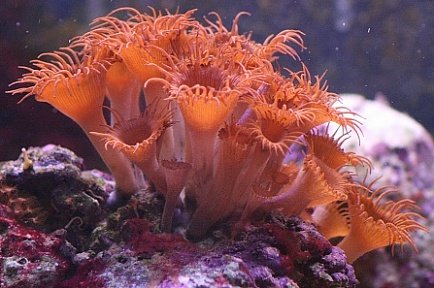flanque
Aquarium Advice FINatic
- Joined
- Jun 9, 2004
- Messages
- 740
Hi all,
It's been sssooo long since I've been here and for about as long I've had almost no time to maintain my tank. Here's a summary:
3 foot, 45KG live rock, 180L (less the rock), 1200L/hr canister filter, HOB multi-skimmer (includes protein skimmig function), 2x35w fluros (white/blue), 1x 12L/hr power head, air pump (large bubbles to break surface), 2x perc clowns, 1x scopas tang, 1x orange tail damsel and a handful of corilamorphs. I can see from time to time tube worms around the place too.
I have the Eheim 3581 automatic feeder set to feed once daily. Side note: this was such a great investment!
Here's the problem... I have a major cyno problem. Generally all other algae is OK.. I am suposing due to the tang (champion). I've done probably 2x 25L salt water changes in 2yrs and never check my levels (ph, alk, sanility, and the other usuals) anymore. The lights run for 6hrs daily.
I've purchased Antired twice but couldn't bring myself to use it without doing something more "natural" beforehand.
So, what I am looking for is some feedback about how to get my tank back into shape. My general plan is to perform an initial physical removal of the red algae and proceed to perform fortnightly or even weekly 25L water changes and replace the filter media once a month. I don't particularly think my feeding is over the top.
I assume this'll be a slow process, but if I can avoid using Antired then I'd like to do that.
Any other tips or suggestions?
It's been sssooo long since I've been here and for about as long I've had almost no time to maintain my tank. Here's a summary:
3 foot, 45KG live rock, 180L (less the rock), 1200L/hr canister filter, HOB multi-skimmer (includes protein skimmig function), 2x35w fluros (white/blue), 1x 12L/hr power head, air pump (large bubbles to break surface), 2x perc clowns, 1x scopas tang, 1x orange tail damsel and a handful of corilamorphs. I can see from time to time tube worms around the place too.
I have the Eheim 3581 automatic feeder set to feed once daily. Side note: this was such a great investment!
Here's the problem... I have a major cyno problem. Generally all other algae is OK.. I am suposing due to the tang (champion). I've done probably 2x 25L salt water changes in 2yrs and never check my levels (ph, alk, sanility, and the other usuals) anymore. The lights run for 6hrs daily.
I've purchased Antired twice but couldn't bring myself to use it without doing something more "natural" beforehand.
So, what I am looking for is some feedback about how to get my tank back into shape. My general plan is to perform an initial physical removal of the red algae and proceed to perform fortnightly or even weekly 25L water changes and replace the filter media once a month. I don't particularly think my feeding is over the top.
I assume this'll be a slow process, but if I can avoid using Antired then I'd like to do that.
Any other tips or suggestions?








